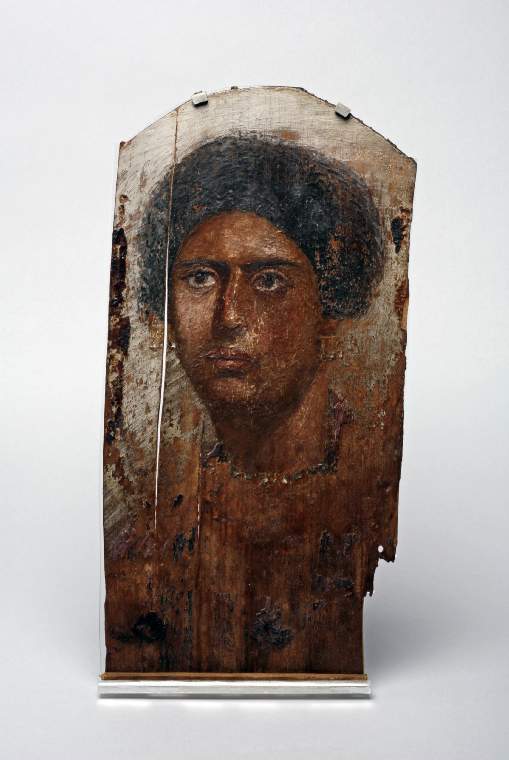

Object number: E.102.1911
Description: Mummy portrait of a woman from Hawara, Egypt. In 1888 Petrie discovered the painted portraits at Hawara in the Fayûm. In all, Petrie removed 146 from the ground in two seasons of excavation (1888 and 1910/11). This panel comes from the second season of excavation. It was given to the Fitzwilliam Museum by Petrie in 1911. A photograph of this portrait is included in Petrie’s 1911 publication Roman portraits and Memphis (IV).
Measurements: H. 39cm W. 20cm D. 0.2cm
Analysis: Encaustic technique on limewood. The support is a single piece of lime with vertical grain (identified by Caroline Cartwright of the British Museum, 1996). The panel is very thin and has split in several places. The top of the panel has been cut in a rough semi-circle after painting, probably shortly before being placed on the mummy. The sides were probably cut down at the same time. A part of the support on the lower proper left-hand side has bene lost. Above this area are two splits and a small hole. As is the case with E.2.1888, the painting was attached to an auxiliary support (made of plywood) at some point during or after the 1950s when the painting was photographed. There are quite large patches of dark resin and pieces of textiles adhered to the reverse of the panel. These are visible in X-ray and are materials associated with burial.
The ground is formed from a cool great colour but it does not seem to lie under the hair and face. It is also unclear whether it formerly lay under the clothing in the foreground. The foreground of the painting is especially damaged and only fragments of paint remain. No underdrawing is visible. The medium used for the decoration is either pure beeswax or a saponified beeswax (Punic wax). Given the presence of lead soaps in the samples tested, it is impossible to say whether the medium was deliberately saponified. The use of esparto wax has been discounted. The pigments identified from sampling include chalk/calcite, lead white, gypsum, bone white, quartz/glass, charcoal, yellow ochre, red lake (type unidentified) and iron oxide red.
Both brushes and tools have been used. The painting style is bold and loose and the painting has the appearance of having been executed rapidly to a well-practised formula. There only appears to be one layer of grey in the background of this painting, unlike in the case of the bearded man also from Hawara (E.2.1888). Reserve has been left for all the chief compositional elements.
There is no obvious discolouration to the paint itself. However, much of the paint has been lost and the paint that remains is covered with a thick layer of wax making judgement difficult. There are extensive losses in the lower reaches of the painting, although fragments of purple, green and yellow paint can still be discerned. There are also areas of raised paint along the two major splits in the support. In the past, the painting was consolidated in the field by Petrie using parrafin wax. In addition, as previously mentioned, the painting was affixed to a plywood auxiliary support at some point in or after the 1950s. There are traces of two campaigns of glue on the reverse of the painting indicating its attachment to a previous auxiliary support prior to the plywood.
Other relevant objects in the Museum’s collection: E.63.1903, E.5.1981, E.2.1888, E.111.1932, E.W.50, E.W.48, E.110.1891, E.W.52.

Mummy portrait of a woman from Hawara. Fitzwilliam Museum: E.102.1911.